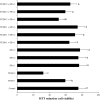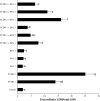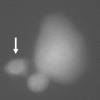Eicosapentaenoic acid protects against 2,3,7,8-tetrachlorodibenzo-p-dioxin-induced hepatic toxicity in cultured rat hepatocytes
- PMID: 21938470
- PMCID: PMC3261452
- DOI: 10.1007/s10616-011-9386-1
Eicosapentaenoic acid protects against 2,3,7,8-tetrachlorodibenzo-p-dioxin-induced hepatic toxicity in cultured rat hepatocytes
Abstract
2,3,7,8-Tetrachlorodibenzo-p-dioxin (TCDD) is a persistent and ubiquitous environmental contaminant. The health impact of TCDD exposure is of great concern to the general public. Recent reports have implied that eicosapentaenoic acid (EPA) might be a potential chemopreventive agent and influence hepatotoxicity. The aim of the current study was to explore the effectiveness of EPA in alleviating the toxicity of TCDD on primary cultured rat hepatocytes. EPA (5, 10 and 20 μM) was added to cultures alone or simultaneously with TCDD (5 and 10 μM). Rat hepatocytes were treated with TCDD and EPA for 48 h, and then cytotoxicity was detected by [3-(4,5-dimethyl-thiazol-2-yl) 2,5-diphenyltetrazolium bromide] (MTT) assay and lactate dehydrogenase (LDH) release, while total antioxidant capacity (TAC) and total oxidative stress (TOS) levels were determined to evaluate the oxidative injury. The DNA damage was also analyzed by liver micronucleus assay (LMN) and 8-oxo-2-deoxyguanosine (8-OH-dG). The results of MTT and LDH assays showed that TCDD but not EPA decreased cell viability. TCDD also increased TOS level and significantly decreased TAC level in rat hepatocytes in a clear dose dependent manner. On the basis of increasing doses, the dioxin caused significant increases of micronucleated hepatocytes (MNHEPs) and 8-OH-dG as compared to control culture. Whereas, in cultures treated with EPA alone, TOS level did not change and the level of TAC significantly increased. The presence of EPA with TCDD minimized the toxic effects of the dioxin on primary hepatocytes cultures. Noteworthy, EPA has a protective effect against TCDD-mediated DNA damages.
Figures





Similar articles
-
Ameliorative effect of supplementation with L-glutamine on oxidative stress, DNA damage, cell viability and hepatotoxicity induced by 2,3,7,8-tetrachlorodibenzo-p-dioxin in rat hepatocyte cultures.Cytotechnology. 2012 Dec;64(6):687-99. doi: 10.1007/s10616-012-9449-y. Epub 2012 Mar 28. Cytotechnology. 2012. PMID: 22453904 Free PMC article.
-
Propolis protects against 2,3,7,8-tetrachlorodibenzo-p-dioxin-induced toxicity in rat hepatocytes.Food Chem Toxicol. 2012 Jun;50(6):2142-8. doi: 10.1016/j.fct.2011.09.018. Epub 2011 Sep 19. Food Chem Toxicol. 2012. PMID: 21963951
-
Ameliorative effects of docosahexaenoic acid on the toxicity induced by 2,3,7,8-tetrachlorodibenzo-p-dioxin in cultured rat hepatocytes.Toxicol Ind Health. 2016 Jun;32(6):1074-85. doi: 10.1177/0748233714547382. Epub 2014 Sep 3. Toxicol Ind Health. 2016. PMID: 25187318
-
The effect of laurel leaf extract against toxicity induced by 2,3,7,8-tetrachlorodibenzo-p-dioxin in cultured rat hepatocytes.Arh Hig Rada Toksikol. 2011 Dec;62(4):309-15. doi: 10.2478/10004-1254-62-2011-2118. Arh Hig Rada Toksikol. 2011. PMID: 22202464
-
Hepatoprotective potential of astaxanthin against 2,3,7,8-tetrachlorodibenzo-p-dioxin in cultured rat hepatocytes.Toxicol Ind Health. 2014 Mar;30(2):101-12. doi: 10.1177/0748233712452607. Epub 2012 Jul 9. Toxicol Ind Health. 2014. PMID: 22778115
Cited by
-
Eicosapentaenoic acid prevents TCDD-induced oxidative stress and inflammatory response by modulating MAP kinases and redox-sensitive transcription factors.Br J Pharmacol. 2015 Oct;172(19):4726-40. doi: 10.1111/bph.13247. Epub 2015 Aug 13. Br J Pharmacol. 2015. PMID: 26177858 Free PMC article.
-
Fish oil rich in eicosapentaenoic acid protects against oxidative stress-related renal dysfunction induced by TCDD in Wistar rats.Cell Stress Chaperones. 2014 May;19(3):409-19. doi: 10.1007/s12192-013-0470-7. Epub 2013 Oct 11. Cell Stress Chaperones. 2014. PMID: 24114387 Free PMC article.
-
2,3,7,8-Tetrachlorodibenzo-p-dioxin (TCDD) alters hepatic polyunsaturated fatty acid metabolism and eicosanoid biosynthesis in female Sprague-Dawley rats.Toxicol Appl Pharmacol. 2020 Jul 1;398:115034. doi: 10.1016/j.taap.2020.115034. Epub 2020 May 5. Toxicol Appl Pharmacol. 2020. PMID: 32387183 Free PMC article.
-
The in vitro protective effect of salicylic acid against paclitaxel and cisplatin-induced neurotoxicity.Cytotechnology. 2016 Aug;68(4):1361-7. doi: 10.1007/s10616-015-9896-3. Epub 2015 Jul 22. Cytotechnology. 2016. PMID: 26199062 Free PMC article.
-
Olive leaf extract modulates permethrin induced genetic and oxidative damage in rats.Cytotechnology. 2012 Aug;64(4):459-64. doi: 10.1007/s10616-011-9424-z. Epub 2012 Jan 20. Cytotechnology. 2012. PMID: 22262123 Free PMC article.
References
-
- Andersson P, Rubio C, Poellinger L, Hanberg A. Gastric hamartomatous tumours in a transgenic mouse model expressing an activated dioxin/Ah receptor. Anticancer Res. 2005;25:903–911. - PubMed
-
- Banudevi S, Arunkumar A, Sharmila M, Senthilkumar J, Balasubramanian K, Srinivasan N, Aruldhas MM, Arunakaran J. Diallyl disulfide-induced modulation of a few phase I and II drug metabolizing enzymes on Aroclor 1254 toxicity in Rattus norvegicus liver and ventral prostate. J Clin Biochem Nutr. 2005;36:59–65. doi: 10.3164/jcbn.36.59. - DOI
LinkOut - more resources
Full Text Sources
Research Materials

